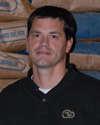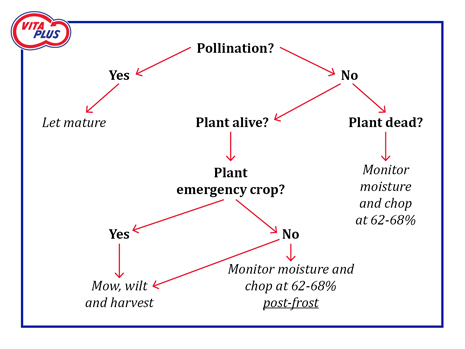
2012 drought: When to harvest and pricing corn


 By Dr. John Goeser, Chris Wacek-Driver and Randy Greenfield
By Dr. John Goeser, Chris Wacek-Driver and Randy Greenfield
(Editors note: Scroll to the bottom of this article for a full webinar recording on this topic as well as PowerPoint slides from the presentation.) Many of you are facing drought conditions and re-thinking your forage strategy as a result. Make your decisions based on actual conditions and move forward after careful consideration of your options. Here are a few tips from your Vita Plus forage team:
Assessing the plant
- The first step is to assess whether or not the plant is dead. If it’s still alive, watch for pollination over the next week or two and decide your next step accordingly. Click here for a technical bulletin that will help you assess the plant’s current physiological status and proceed in the decision-making process based on pollination progress.
- Watch this video from Dr. Joe Lauer with the University of Wisconsin Agronomy Department. He will walk you through the steps of determining whether or not pollination has occurred.
- We estimate that the energy value of this crop will be between 65 and 85 percent of a normal corn silage. We will likely see improved fiber digestibility with less lignification due to drought stress.
- If you are buying and selling drought-stressed corn silage based on nutrient quality, use a wet chemistry analysis from a forage lab. This will give you the most accurate nutrient values.
Harvesting corn silage
- Whether or not the plant has pollinated will determine the direction you take for harvesting.

- Carefully monitor your moisture levels at harvest – don’t put it up too wet. Between 62 and 68 percent moisture is considered ideal.
- Nitrates are a concern with drought-stressed corn and the test is cheap. Test for nitrates. We recommend waiting five to seven days to harvest after rainfall to avoid high nitrates.
- Inoculate. UV light limits natural bacteria on the field. Inoculants help ensure good fermentation.
- Keep your custom harvesters in the loop by updating them with the status of your fields and moistures. This goes a long way in planning and scheduling when to chop.
Pricing this year’s crop
- Silage with little or no grain should be priced as small grain or grass silage using its RFV or RFQ as a quality guide.
- Use spreadsheet guides to develop fair price offers to grain producers that have corn with some grain content.
- Accurate measures of grain bushels and silage tonnage will increase the likelihood of fair pricing.
- Ultimately, local supply and demand will dictate pricing.
- Click here for a spreadsheet created by the University of Wisconsin Extension Forage Team. This tool will help you calculate the value of your corn silage from both the buyer’s and the seller’s perspective.
Watch the full webinar Click here for the PowerPoint slides shared in the webinar presentation. Additional resources
- University of Wisconsin Corn Agronomy Updates
- University of Wisconsin Corn Agronomy Blog
- Special thanks to Dr. Joe Lauer with the University of Wisconsin Agronomy Department for his leadership in these resources.
About the authors: Dr. John Goeser, formerly with Vita Plus, works with Rock River Laboratory, Inc. He grew up on his family’s 1,200-cow dairy in eastern Wisconsin. He earned master’s degrees at the University of Wisconsin-Madison in both plant breeding and genetics and dairy nutrition. His researched produced a better understanding of how corn silage genetics influence dairy cattle productivity. He went on to earn his PhD in dairy nutrition and spent five years in research at the university. His doctorate research developed an improved method for measuring fiber digestibility, which UW-Madison patented and is now being used commercially. Chris Wacek-Driver is the Vita Plus forage program manager. She grew up on a farm outside of Denmark, Wis. and attended the University of Wisconsin-River Falls where she earned her bachelor’s degree in dairy science with an ag business minor. She went on to receive her master’s degree from UW-Madison. She conducted her research focusing on forage quality at the USDA Forage Center under Dr. Larry Satter. In particular, she studied forage fermentation, the role of microbial and enzyme additives, and their effects on dairy animal performance. Wacek-Driver has been a Vita Plus employee owner for the past 21 years and worked in dairy technical services prior to her current role. She has a passion for working with dairy producers to help them with on-farm feed inventory, feed management, forage fermentation and production, and dairy nutrition. She resides on a 240-acre farm along the bluffs of the Mississippi River in western Wisconsin. Randy Greenfield is a Vita Plus dairy specialist. For the past 13 years, he has worked with dairy producers to help them strengthen their nutrition and management programs. Greenfield grew up on his family’s dairy farm near Waupun, Wis. and attended the University of Wisconsin-River Falls to earn his bachelor’s degree. He went on to receive his master’s degree from Purdue University. In addition to nutrition, Greenfield has taken a special interest in dairy records and business consulting.
| Category: |
Dairy Performance Drought Forage harvesting |

